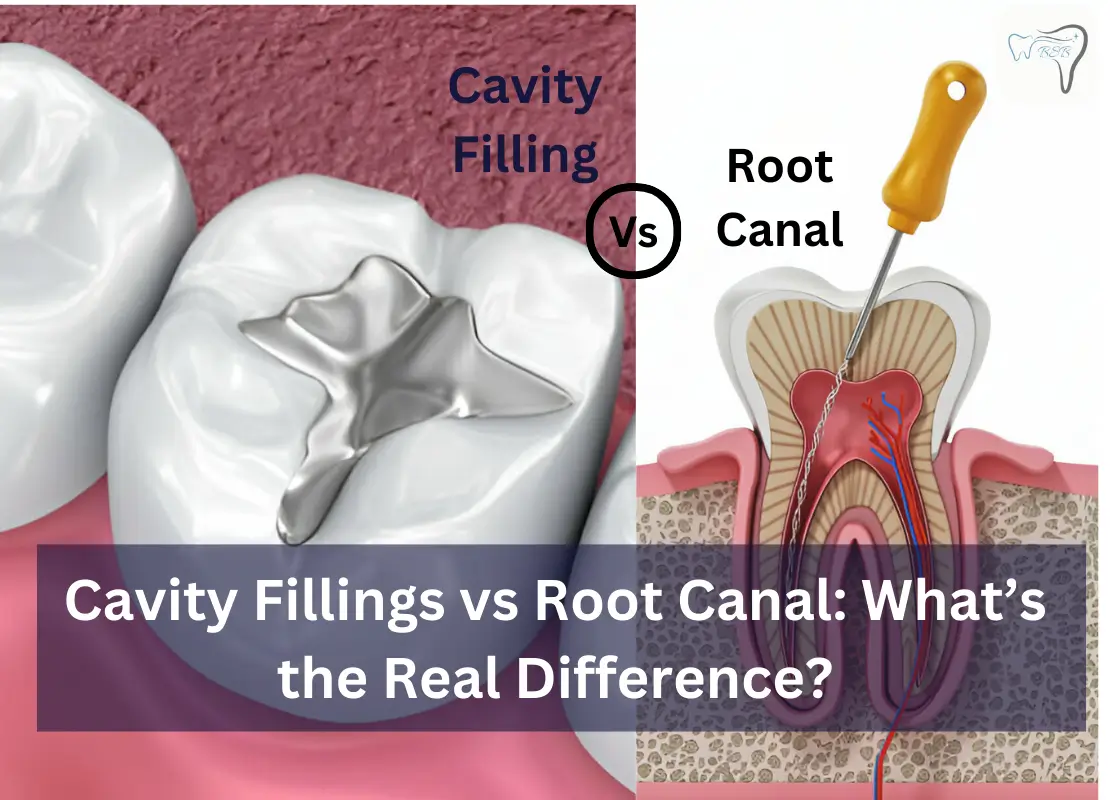Having treated countless dental problems, I’ve observed how tooth decay and caries impact quality of life. When cavities in teeth progress beyond surface decay, they affect soft tissue and nerves, causing pain and potential imposthumate.
While basic dental care and restorative dentistry address dental injury and trauma, deeper infections and inflammation in the root canal systems require advanced treatment. The affected tooth’s damaged tissue needs swift intervention to maintain integrity, preventing further complications.
Cavity Fillings vs Root Canal: What’s the Real Difference?(Short Answer)
Here are the differences between root canal treatment and filling:
As a dentist, I’ll explain how filling and composite dental fillings differ from root canal treatment. While fillings treat surface cavities and decays causing sensitivity, deep tooth decay reaching the dental pulp requires more care.
When teeth develop painful inflammatory abscessed diseases, including gingival abscesses and cysts, we perform intense cleaning, disinfecting, and refilling of canals. The procedure involves treating dental nerves, which are decontaminated to address inflammation, infection, and damage from trauma or gum diseases.
We remove infected walls, ensure shaped canals don’t leak, apply top filling, and use specific materials for repair. While cost varies, treating a compromised or exposed root prevents further issues in the next 24 hours.
Root Canal Treatment
As a dentist, I’ve found that root canal treatment effectively preserves your natural tooth versus needing dentures. The procedure involves cleaning and removing dead pulp and decaying pulp, then re-sealing with a crown.
While efficient for chewing and aesthetically pleasing, helping protect adjacent teeth from overuse, it needs multiple visits. Though it may weaken teeth, we can usually eradicate any infection.
Filling
A filling involves surgical insertion of a material into a damaged tooth to restore its shape and prevent further decay. It’s cheap, protects against further damage, and can help avoid a root canal. However, some materials deteriorate rapidly, leading to new cavities, infections, and poor aesthetics.
In which cases is the filling applied?
- For early cavities and tooth surface damage, a filling can repair teeth exhibiting mild cold sensitivity without intense pain.
- When dental nerves aren’t affected, we treat fractures with simple tooth filling process.
- Abrasions from hard brushing or gingival recession can be aesthetically restored efficiently.
In which situations is root canal treatment applied;
- Caries: Root canal treatment is needed when deep caries reach the dental nerves, requiring cleaning and refilling of root canals.
- Gingivitis: In gum disease, infection can affect the roots, making root canal treatment necessary.
- Trauma: Root canal treatment saves a tooth when dental nerves are damaged due to falling, breaking, or movement.
- Abscess: If dental caries causes inflammation and an abscess, root canal treatment is required.
- Advanced Infections: When infection spreads to the roots, root canal treatment removes it and restores the tooth.
Root Canal vs Cavity Filling – Comparing Procedures
A cavity filling is a straightforward process where the dentist numbs the affected area, removes the decayed part of the tooth, and fills it with a tooth-colored composite resin material. After it is shaped, cured, and polished, the procedure is complete.
In contrast, a root canal is more complex, involving the removal of decayed tissue and the pulp inside the tooth. The dentist cleans and shapes the root canals, then fills them with a temporary composite before placing a permanent crown after a second appointment. This treatment addresses infection, pain, and inflammation in the deeper parts of the tooth.
How to Know If You Need a Filling or Root Canal
Although there are numerous similarities, it is possible to identify the specific treatment needed for your cavity or decay by considering the symptoms you are experiencing.
Symptoms for Root Canals
If you experience moderate to severe tooth pain, swollen gums, or extreme sensitivity to temperatures, it could signal the need for a root canal. You might also notice a dark spot or cavity, sustained damage, like a loose or fractured tooth, or issues with prior artificial crowns or dentures.
Symptoms for Fillings
If you have toothaches, throbbing or stabbing pains while chewing or biting, and your affected tooth feels sensitive to hot or cold temperatures, a filling may be needed. Minor dental decay like dark spots or small cavities can also indicate this. Additionally, if your floss snaps or gets caught on jagged, cracked, or worn-away areas of the tooth, it’s another sign.
What’s the Cost Difference?
Root canals typically cost more than fillings since they address more severe damage, not just minor decay. The cost varies based on the severity of the damage and the number of teeth affected.
Cost of root canals
A root canal procedure typically ranges from $1,500 to $1,900 per tooth. However, the cost can fluctuate based on factors such as the number of teeth, the extent of infected or dead pulp removal, and how much reshaping of the inner root canals is necessary.
Cost of fillings
Fillings vary in cost depending on the material, the severity of decay, the number of fillings needed, and any additional procedures required before the filling. With the rapid advancements in dental technology, there are now various types of dental fillings made from different materials.These include:
- Amalgam Fillings: Amalgam fillings are typically priced between $50 and $150 per filling. They are silver in colour and made from a mix of mercury, copper, tin, zinc, or silver. These fillings are durable, lasting 10-15 years with proper care.
- Composite Fillings: Composite fillings range in cost from $250 to $400 per filling. These fillings are customized to match the natural appearance of your teeth but may not last as long as amalgams. They also require less tooth structure to be altered.
- Gold Fillings: The price for gold fillings can vary from $900 to $4500 per filling. These are among the most durable, lasting up to 20 years with proper oral hygiene and maintenance.
- Porcelain Fillings: Porcelain fillings cost between $900 and $4500 per filling. They are long-lasting and can be matched to the colour of your teeth, but they are on the pricier side.
- Glass Ionomer Fillings: Glass ionomer fillings range from $150 to $300 per filling. While not as strong as composite resin, they are useful for babies and in areas below the gum line.
- Temporary Filling: Temporary fillings typically cost between $50 and $150 per filling. These are made from softer material and are easier to remove when needed.
Conclusion
Cavity fillings are used for early-stage decay, restoring the tooth’s shape and preventing further damage, while root canal treatment is needed for deeper infections affecting the tooth’s pulp and nerves. Fillings are less invasive, but root canals preserve the natural tooth when damage is more severe. Both treatments are essential, depending on the extent of the tooth’s damage.
Ferquently Asked Questions(FAQ’s)
Is filling a cavity the same as a root canal?
No, a filling treats minor cavities, while a root canal is needed when infection reaches the pulp. During a root canal, the infected pulp, including blood vessels and nerves, is removed, the tooth is filled, and a crown is often added for protection.
What happens if I get a filling instead of a root canal?
Choosing a filling over a root canal can lead to complications if the infection reaches the pulp. While a filling works for minor tooth damage, deep decay may cause persistent pain or worsen the infection, eventually requiring a root canal or even an extraction.
Why do dentists always recommend root canals?
Dentists suggest root canals to save infected or damaged teeth, preventing further infection and tooth loss. This procedure relieves pain, restores function, and protects overall oral health. Without a root canal, the condition may worsen, leading to more severe dental issues.

